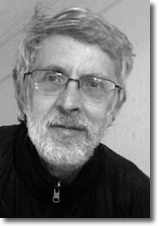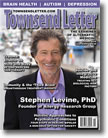Page 1, 2, 3
BF: Regarding John Diamond – what is your view of muscle testing and applied kinesiology?
SL: This technology is valid in the right hands, a fact that's quickly realized by anyone who has worked with a master practitioner like Diamond. Another master of this approach is Nipa Das. A search at YouTube for "Practical Kinesiology Tips from Dr. Nipa Das" produces a wonderful short video of her at work.
BF: Some supplement companies use magnesium stearate as a flow agent for manufacturing. Some companies, commentators, and consumers are concerned about this. What's your opinion?
SL: I agree with the author and practitioner Chris Kresser: "There are a lot of misconceptions and inaccurate statements about magnesium stearate floating around." There is no real evidence against it. It's hard to imagine why there would be a problem – we're talking about magnesium and stearic acid, both of which are nutritional ingredients that actually have benefits. Many people are walking around with a magnesium deficiency. Stearic acid is a generally healthy food. The amount of magnesium stearate used as a lubricant is only going to be 1% or 2% of a capsule content.
BF: With regard to the active ingredients in supplements – do consumers need to be careful about country of origin?
SL: There is a legitimate concern. The Chinese, notoriously, and other countries as well, don't have the same concern about toxic compounds that we do, especially toxic metals. Extra quality control can make a large difference. It's my impression, as I mentioned, that the big supplement companies in North America have strong quality control procedures.
BF: Do you think there's any difference to the body between natural and synthetic vitamins?
SL: I do think there is a difference. Natural can be best. But with natural products there can be allergy and purity issues, and you often don't get adequate concentrations, so in some cases we need the synthetic products. You can't get enough vitamin C from natural sources to achieve numerous of its benefits. The same is true for some of the B vitamins. Vitamin C research is done with the synthesized product with a large number of publications annually. The quoted research by Linus Pauling is largely with synthetic C so far as I am aware. Melatonin supplements are synthetic.
BF: What big-picture trends are you seeing for the supplement industry?
SL: Larger companies are gobbling up smaller companies. A Canadian company spent $100,000,000 for the Douglas Laboratories brand. Alticor bought a big piece of Metagenics. This is happening partly because smaller companies find it difficult to deal with harassment threats and ever-increasing regulations.
It's harder today to get into the business than it was for me in the 1980s. Patents are more of a challenge. And there's a "new ingredient" issue – if you use something that's construed as a new ingredient, you are required to apply for approval by the government. These applications are often rejected. Also, in California, there are Proposition 65 issues having to do with toxic metals.
In terms of new products, I think there will be a boom in nutrients that can be applied topically, such as coenzyme Q10 and DHEA. Magnesium lotion products may have a lot of merit; with them, you can steer clear of digestive tract issues. As I mentioned, magnesium deficiencies are common.
On a product development level, some nutritional concepts are merging with pharmaceutical product concepts. Pharmaceutical companies are selling more nutrients and derivatives of nutrients. Nutritional supplement companies are tailoring nutrients to be more targeted by using pure extracts and even pure isolates.
Can I mention another supplement that I take that I'm excited about but is under the radar for many people?
BF: Please do.
SL: There are several supplements that target Nrf2. I take Nrf2 Renew, several capsules daily. It uses natural ingredients, including green tea and milk thistle, to raise Nrf2 levels and stimulate the Nrf2 pathway.
BF: You're pronouncing Nrf2 as "nerf two." Please elaborate.
SL: The Nrf2 system was discovered in 1997 by Masayuki Yamamoto in Japan. It's a profound system for cellular protection. It's triggered in part by certain antioxidants in our diet and in supplements.
The Nrf2 system involves a number of interrelated functions performed by the cells to sense primarily oxidative stress. The system turns on genes that code for a variety of well-known defense enzymes and related factors. These then provide broad-ranging protection and enhancement of cellular defense, vitality, and detoxification functions.
I see Nrf2 as a new phase in our understanding about antioxidants. It's as big, important, and deep as the first phase of antioxidant research that we described in our textbook in 1985.
BF: Why do we need a supplement to raise Nrf2? Isn't a well-nourished body capable of doing an adequate job?
SL: Nrf2 Renew has an array of nutrients that most people probably don't get enough of. Our soil may be more damaged than in centuries past. We eat food that may not be of high quality. With the enormous stress and toxicity we live with, it makes sense to provide extra of the signaling agents to turn on this magnificent detoxification assemblage.
BF: Isn't it the case that drug companies are looking closely at Nrf2 hoping to find ways to stimulate the system?
SL: Yes, it's a hot topic for research. A good review article, in my opinion, is by Martin L. Pall and me, published in the Townsend Letter in October 2015. Pall is at Washington State University; he worked with Allergy Research Group as a consultant to create Nrf2 Renew.
BF: I'll insert here an excerpt from a paper you cowrote with Martin Pall as published in a scholarly journal in 2015:
Raising Nrf2 has been found to prevent and/or treat a large number of chronic inflammatory diseases in animal models and/or humans including various cardiovascular diseases, kidney diseases, lung diseases, diseases of toxic liver damage, cancer (prevention), diabetes/metabolic syndrome/obesity, sepsis, autoimmune diseases, inflammatory bowel disease, HIV/AIDS and epilepsy. Lesser evidence suggests that raising Nrf2 may lower 16 other diseases.6
SL: Marty did most the literature review and produced the manuscript.
BF: Finally, Stephen, you're known as a seeker interested in expanding consciousness. Can you recommend some books in this realm?
SL: Sure!
The Synchronized Universe, by Claude Swanson, summarizes a lot of consciousness research.
A Course in Miracles, by the Foundation for Inner Peace, is brilliant contemporary religious philosophy. It's transforming.
Anything by Robert O. Becker, including The Body Electric, Electromagnetism and Life, and Cross Currents.
Osho, also known as Rajneesh, was an enlightened mystic who has impacted millions of people. He was a prolific author – his lectures were transcribed. One of his books is Courage: The Joy of Living Dangerously. Here's an excerpt: "So to be courageous means to live with the heart. And weaklings, only weaklings, live with the head; afraid, they create a security of logic around themselves. Fearful, they close every window and door – with theology, concepts, words, theories – and inside those closed doors and windows, they hide. The way of the heart is the way of courage. It is to live in insecurity."
BF: "A security of logic" – a powerful phrase. I'm reminded of the late Victor Herbert, MD, a famous opponent of Linus Pauling. I visited Herbert at his New York City apartment in the 1990s and listened to him rage for two hours at Pauling. He hated Pauling. As I think about him now, I'm inclined to think he built his life around the reassuring security of set-in-stone legalisms.
SL: A lot of people live in their head and carry enormous egos. The ego is a trickster that keeps you in your head. If you stay in your heart you're humble.
If the brain is a servant to the awakened heart, then our actions will be guided by more equanimity, love, joy, and compassion. The next step in our evolution is to let the awakened heart oversee the use of the mind. Then our knowledge can lead to wisdom.
Page 1, 2, 3
Notes .pdf

Bob Frost is a journalist in San Francisco specializing in coverage of health topics. He wrote about health care for many years for West, the Sunday magazine of the San Jose Mercury News, newspaper of record for Silicon Valley, including cover stories about pain, allergies, and the Great Influenza Pandemic of 1918. His e-mail address is bobfrostmail@aol.com.
|
![]()
![]()
![]()





